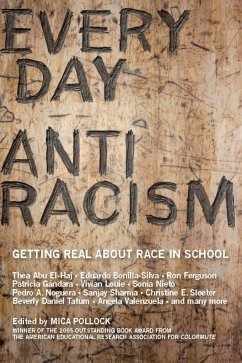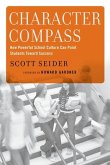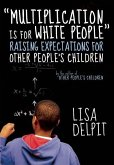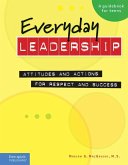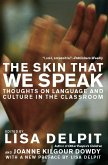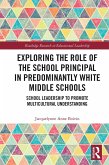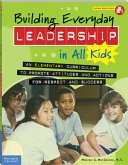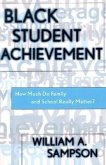Everyday Antiracism
Getting Real about Race in School
Herausgeber: Pollock, Mica
22,99 €
inkl. MwSt.
Versandfertig in über 4 Wochen

11 °P sammeln
Everyday Antiracism
Getting Real about Race in School
Herausgeber: Pollock, Mica
- Broschiertes Buch
- Merkliste
- Auf die Merkliste
- Bewerten Bewerten
- Teilen
- Produkt teilen
- Produkterinnerung
- Produkterinnerung
In "Everyday Antiracism," leading educators deal with the most challenging questions about race in school, offering invaluable and effective advice. Contributors including Beverly Daniel Tatum, Sonia Nieto, Pedro Noguera, and others.
Andere Kunden interessierten sich auch für
![Character Compass Character Compass]() Scott SeiderCharacter Compass38,99 €
Scott SeiderCharacter Compass38,99 €![Multiplication Is for White People Multiplication Is for White People]() Lisa DelpitMultiplication Is for White People17,99 €
Lisa DelpitMultiplication Is for White People17,99 €![Everyday Leadership Everyday Leadership]() Mariam G MacGregorEveryday Leadership15,99 €
Mariam G MacGregorEveryday Leadership15,99 €![The Skin That We Speak The Skin That We Speak]() The Skin That We Speak17,99 €
The Skin That We Speak17,99 €![Exploring the Role of the School Principal in Predominantly White Middle Schools Exploring the Role of the School Principal in Predominantly White Middle Schools]() Jacquelynne Anne BoivinExploring the Role of the School Principal in Predominantly White Middle Schools64,99 €
Jacquelynne Anne BoivinExploring the Role of the School Principal in Predominantly White Middle Schools64,99 €![Building Everyday Leadership in All Kids Building Everyday Leadership in All Kids]() Mariam G MacGregorBuilding Everyday Leadership in All Kids31,99 €
Mariam G MacGregorBuilding Everyday Leadership in All Kids31,99 €![Black Student Achievement Black Student Achievement]() William A SampsonBlack Student Achievement75,99 €
William A SampsonBlack Student Achievement75,99 €-
-
-
In "Everyday Antiracism," leading educators deal with the most challenging questions about race in school, offering invaluable and effective advice. Contributors including Beverly Daniel Tatum, Sonia Nieto, Pedro Noguera, and others.
Hinweis: Dieser Artikel kann nur an eine deutsche Lieferadresse ausgeliefert werden.
Hinweis: Dieser Artikel kann nur an eine deutsche Lieferadresse ausgeliefert werden.
Produktdetails
- Produktdetails
- Verlag: New Press
- Seitenzahl: 389
- Erscheinungstermin: 1. Juni 2008
- Englisch
- Abmessung: 234mm x 160mm x 28mm
- Gewicht: 454g
- ISBN-13: 9781595580542
- ISBN-10: 1595580549
- Artikelnr.: 23388345
- Herstellerkennzeichnung
- Libri GmbH
- Europaallee 1
- 36244 Bad Hersfeld
- gpsr@libri.de
- Verlag: New Press
- Seitenzahl: 389
- Erscheinungstermin: 1. Juni 2008
- Englisch
- Abmessung: 234mm x 160mm x 28mm
- Gewicht: 454g
- ISBN-13: 9781595580542
- ISBN-10: 1595580549
- Artikelnr.: 23388345
- Herstellerkennzeichnung
- Libri GmbH
- Europaallee 1
- 36244 Bad Hersfeld
- gpsr@libri.de
Mica Pollock is an associate professor at the Harvard Graduate School of Education. An anthropologist of education, she previously taught tenth grade and worked in the civil rights field. She is the author of Colormute and Because of Race. She lives in Somerville, Massachusetts.
Contents
Acknowledgments xi
Suggestions for Using This Book xiii
Introduction: Defining Everyday Antiracism xvii
SECTION A
RACE CATEGORIES: WE ARE ALL THE SAME,
BUT OUR LIVES ARE DIFFERENT 1
Part I: Remember That Racial Categories Are
Not Biological Realities 3
1. Exposing Race as an Obsolete Biological Concept
Alan H. Goodman 4
2. No Brain Is Racial
Mica Pollock 9
3. Getting Rid of the Word "Caucasian"
Carol C. Mukhopadhyay 12
Part II: Get Ready to Talk about a Racialized Society 17
4. Beginning Courageous Conversations about Race
Glenn E. Singleton and Cyndie Hays 18
5. Talking Precisely about Equal Opportunity
Mica Pollock 24
6. Nice Is Not Enough: Defining Caring for Students of Color
Sonia Nieto 28
Part III: Remember That People Do Not Fit Neatly and
Easily into Racial Groups 33
7. Following Children's Leads in Conversations about Race
Kimberly Chang and Rachel Conrad 34
8. Observing Students Sharing Language
Ben Rampton 39
Part IV: Remember That People Are Treated as Racial Group
Members and Need to Examine That Experience 43
9. Strengthening Student Identity in School Programs
Patricia Gándara 44
10. Uncovering Internalized Oppression
Angela Valenzuela 50
11. Helping Students See Each Other's Humanity
L. Janelle Dance 56
Part V: Emphasize Individuality 61
12. Constructing Colorblind Classrooms
Samuel R. Lucas 62
13. Knowing Students as Individuals
Joshua Aronson 67
14. Showing Students Who You Are
Heather M. Pleasants 70
SECTION B
HOW OPPORTUNITIES ARE PROVIDED
AND DENIED INSIDE SCHOOLS 75
Part VI: Remember That Students Experience Racially
Unequal Expectations about Their Brainpower 77
15. Helping Students of Color Meet High Standards
Ronald F. Ferguson 78
16. Providing Supportive Feedback
Geoffrey L. Cohen 82
Part VII: Counter Racially Patterned Skill Gaps 85
17. Teaching and Transcending Basic Skills
Amanda Taylor 86
18. Grouping in Detracked Classrooms
Beth C. Rubin 90
Part VIII: Help Students Gain Fluency in "Standard"
Behaviors While Honoring the "Nonstandard"
Behaviors They Already Have 97
19. Standards vs."Standard" Knowledge
Edmund T. Hamann 98
20. Valuing Nonstandard English
John Baugh 102
21. Teaching Students Fluency in Multiple Cultural Codes
Prudence Carter 107
Part IX: Defy Racially Based Notions of Potential
Careers and Contributions 113
22. Challenging Cultural Stereotypes of "Scientific Ability"
Maria Ong 114
23. Finding Role Models in the Community
Meira Levinson 120
Part X: Analyze Racial Disparities in Opportunities to Learn 125
24. Providing Equal Access to "Gifted" Education
Karolyn Tyson 126
25. What Discipline Is For: Connecting Students to the
Benefits of Learning
Pedro A. Noguera 132
SECTION C
CURRICULUM THAT ASKS CRUCIAL
QUESTIONS ABOUT RACE 139
Part XI: Create Curriculum That Invites Students to
Explore Complex Identities and Consider
Racial Group Experiences 141
26. Using Photography to Explore Racial Identity
Alexandra Lightfoot 142
27. Exploring Racial Identity Through Writing
Jennifer A. Mott-Smith 146
28. Involving Students in Selecting Reading Materials
Christine E. Sleeter 150
Part XII: Create Curriculum That Analyzes
Opportunity Denial 155
29. Teaching Critical Analysis of Racial Oppression
Jeff Duncan-Andrade 156
30. Using Critical Hip-Hop in the Curriculum
Ernest Morrell 161
31. Engaging Youth in Participatory Inquiry for Social Justice
María Elena Torre and Michelle Fine 165
Part XIII: Create Curriculum That Represents a
Diverse Range of People Thoroughly and Complexly 173
32. Arab Visibility and Invisibility
Thea Abu El-Haj 174
33. Evaluating Images of Groups in Your Curriculum
Teresa L. McCarty 180
34. Teaching Representations of Cultural Difference Through Film
Sanjay Sharma 186
35. What Is on Your Classroom Wall? Problematic Posters
Donna Deyhle 191
36. Teaching Racially Sensitive Literature
Jocelyn Chadwick 195
Part XIV: Create Curriculum That Discusses History
Accurately and Thoroughly 199
37. Making Race Relevant in All-White Classrooms:
Using Local History
Mara Tieken 200
38. Teaching Facts, Not Myths, about Native Americans
Paul Ongtooguk and Claudia S. Dybdahl 204
SECTION D
RACE AND THE SCHOOL EXPERIENCE:
THE NEED FOR INQUIRY 209
Part XV: Investigate Learning Experiences in Your Classroom 211
39. Inviting Students to Analyze Their Learning Experience
Makeba Jones and Susan Yonezawa 212
40. Interrogating Students' Silences
Katherine Schultz 217
41. Questioning "Cultural" Explanations of Classroom Behaviors
Doug Foley 222
42. Creating Safe Spaces in Predominantly White Classrooms
Pamela Perry 226
43. On Spotlighting and Ignoring Racial Group Members
in the Classroom
Dorinda J. Carter 230
Part XVI: Spearhead Conversations with Students about
Racism in Their Lives and Yours 235
44. Racial Incidents as Teachable Moments
Lawrence Blum 236
45. Debating Racially Charged Topics
Ian F. Haney López 242
46. Developing Antiracist School Policy
David Gillborn 246
Part XVII: Talk Thoroughly with Colleagues
about Race and Achievement 253
47. Focusing on Student Learning
John B. Diamond 254
48. Moving Beyond Quick "Cultural" Explanations
Vivian Louie 257
49. Naming the Racial Hierarchies That Arise During School Reforms
Rosemary Henze 262
50. Spearheading School-wide Reform
Willis D. Hawley 267
Part XVIII: Analyze, with Colleagues and Students, How
Your Race Affects Your Teaching 273
51. Responding to the "N-Word"
Wendy Luttrell 274
52. Engaging Diverse Groups of Colleagues in Conversation
Alice McIntyre 279
53. Locating Yourself for Your Students
Priya Parmar and Shirley Steinberg 283
54. Expanding Definitions of "Good Teaching"
Lee Anne Bell 287
SECTION E
ENGAGING COMMUNITIES FOR REAL 291
Part XIX: Inquire Fully about Home Communities 293
55. Valuing Students' Home Worlds
Eugene E. García 294
56. Getting to Know Students' Communities
Leisy Wyman and Grant Kashatok 299
57. Helping Students Research Their Communities
Kathleen Cushman 305
Part XX: Discuss Parents' Experiences of Racially Unequal
Opportunity 309
58. Cultivating the Trust of Black Parents
Beverly Daniel Tatum 310
59. Helping Parents Fight Stereotypes about Their Children
Janie Victoria Ward 314
60. Informing Parents about Available Opportunities
Roslyn Arlin Mickelson and Linwood H. Cousins 318
SECTION F
KEEPING IT GOING 325
Part XXI: Struggle to Change a System That Is Unequal,
While Working Within It 327
61. Resisting the "Lone Hero" Stance
Audrey Thompson 328
62. Recognizing the Likelihood of Reproducing Racism
Eduardo Bonilla-Silva and David G. Embrick 334
63. Staying Hopeful
Ronald David Glass 337
64. What Is Next?
Mica Pollock 341
Complete List of Everyday Antiracist Strategies 343
Notes 349
Reference List 361
Index 381
Acknowledgments xi
Suggestions for Using This Book xiii
Introduction: Defining Everyday Antiracism xvii
SECTION A
RACE CATEGORIES: WE ARE ALL THE SAME,
BUT OUR LIVES ARE DIFFERENT 1
Part I: Remember That Racial Categories Are
Not Biological Realities 3
1. Exposing Race as an Obsolete Biological Concept
Alan H. Goodman 4
2. No Brain Is Racial
Mica Pollock 9
3. Getting Rid of the Word "Caucasian"
Carol C. Mukhopadhyay 12
Part II: Get Ready to Talk about a Racialized Society 17
4. Beginning Courageous Conversations about Race
Glenn E. Singleton and Cyndie Hays 18
5. Talking Precisely about Equal Opportunity
Mica Pollock 24
6. Nice Is Not Enough: Defining Caring for Students of Color
Sonia Nieto 28
Part III: Remember That People Do Not Fit Neatly and
Easily into Racial Groups 33
7. Following Children's Leads in Conversations about Race
Kimberly Chang and Rachel Conrad 34
8. Observing Students Sharing Language
Ben Rampton 39
Part IV: Remember That People Are Treated as Racial Group
Members and Need to Examine That Experience 43
9. Strengthening Student Identity in School Programs
Patricia Gándara 44
10. Uncovering Internalized Oppression
Angela Valenzuela 50
11. Helping Students See Each Other's Humanity
L. Janelle Dance 56
Part V: Emphasize Individuality 61
12. Constructing Colorblind Classrooms
Samuel R. Lucas 62
13. Knowing Students as Individuals
Joshua Aronson 67
14. Showing Students Who You Are
Heather M. Pleasants 70
SECTION B
HOW OPPORTUNITIES ARE PROVIDED
AND DENIED INSIDE SCHOOLS 75
Part VI: Remember That Students Experience Racially
Unequal Expectations about Their Brainpower 77
15. Helping Students of Color Meet High Standards
Ronald F. Ferguson 78
16. Providing Supportive Feedback
Geoffrey L. Cohen 82
Part VII: Counter Racially Patterned Skill Gaps 85
17. Teaching and Transcending Basic Skills
Amanda Taylor 86
18. Grouping in Detracked Classrooms
Beth C. Rubin 90
Part VIII: Help Students Gain Fluency in "Standard"
Behaviors While Honoring the "Nonstandard"
Behaviors They Already Have 97
19. Standards vs."Standard" Knowledge
Edmund T. Hamann 98
20. Valuing Nonstandard English
John Baugh 102
21. Teaching Students Fluency in Multiple Cultural Codes
Prudence Carter 107
Part IX: Defy Racially Based Notions of Potential
Careers and Contributions 113
22. Challenging Cultural Stereotypes of "Scientific Ability"
Maria Ong 114
23. Finding Role Models in the Community
Meira Levinson 120
Part X: Analyze Racial Disparities in Opportunities to Learn 125
24. Providing Equal Access to "Gifted" Education
Karolyn Tyson 126
25. What Discipline Is For: Connecting Students to the
Benefits of Learning
Pedro A. Noguera 132
SECTION C
CURRICULUM THAT ASKS CRUCIAL
QUESTIONS ABOUT RACE 139
Part XI: Create Curriculum That Invites Students to
Explore Complex Identities and Consider
Racial Group Experiences 141
26. Using Photography to Explore Racial Identity
Alexandra Lightfoot 142
27. Exploring Racial Identity Through Writing
Jennifer A. Mott-Smith 146
28. Involving Students in Selecting Reading Materials
Christine E. Sleeter 150
Part XII: Create Curriculum That Analyzes
Opportunity Denial 155
29. Teaching Critical Analysis of Racial Oppression
Jeff Duncan-Andrade 156
30. Using Critical Hip-Hop in the Curriculum
Ernest Morrell 161
31. Engaging Youth in Participatory Inquiry for Social Justice
María Elena Torre and Michelle Fine 165
Part XIII: Create Curriculum That Represents a
Diverse Range of People Thoroughly and Complexly 173
32. Arab Visibility and Invisibility
Thea Abu El-Haj 174
33. Evaluating Images of Groups in Your Curriculum
Teresa L. McCarty 180
34. Teaching Representations of Cultural Difference Through Film
Sanjay Sharma 186
35. What Is on Your Classroom Wall? Problematic Posters
Donna Deyhle 191
36. Teaching Racially Sensitive Literature
Jocelyn Chadwick 195
Part XIV: Create Curriculum That Discusses History
Accurately and Thoroughly 199
37. Making Race Relevant in All-White Classrooms:
Using Local History
Mara Tieken 200
38. Teaching Facts, Not Myths, about Native Americans
Paul Ongtooguk and Claudia S. Dybdahl 204
SECTION D
RACE AND THE SCHOOL EXPERIENCE:
THE NEED FOR INQUIRY 209
Part XV: Investigate Learning Experiences in Your Classroom 211
39. Inviting Students to Analyze Their Learning Experience
Makeba Jones and Susan Yonezawa 212
40. Interrogating Students' Silences
Katherine Schultz 217
41. Questioning "Cultural" Explanations of Classroom Behaviors
Doug Foley 222
42. Creating Safe Spaces in Predominantly White Classrooms
Pamela Perry 226
43. On Spotlighting and Ignoring Racial Group Members
in the Classroom
Dorinda J. Carter 230
Part XVI: Spearhead Conversations with Students about
Racism in Their Lives and Yours 235
44. Racial Incidents as Teachable Moments
Lawrence Blum 236
45. Debating Racially Charged Topics
Ian F. Haney López 242
46. Developing Antiracist School Policy
David Gillborn 246
Part XVII: Talk Thoroughly with Colleagues
about Race and Achievement 253
47. Focusing on Student Learning
John B. Diamond 254
48. Moving Beyond Quick "Cultural" Explanations
Vivian Louie 257
49. Naming the Racial Hierarchies That Arise During School Reforms
Rosemary Henze 262
50. Spearheading School-wide Reform
Willis D. Hawley 267
Part XVIII: Analyze, with Colleagues and Students, How
Your Race Affects Your Teaching 273
51. Responding to the "N-Word"
Wendy Luttrell 274
52. Engaging Diverse Groups of Colleagues in Conversation
Alice McIntyre 279
53. Locating Yourself for Your Students
Priya Parmar and Shirley Steinberg 283
54. Expanding Definitions of "Good Teaching"
Lee Anne Bell 287
SECTION E
ENGAGING COMMUNITIES FOR REAL 291
Part XIX: Inquire Fully about Home Communities 293
55. Valuing Students' Home Worlds
Eugene E. García 294
56. Getting to Know Students' Communities
Leisy Wyman and Grant Kashatok 299
57. Helping Students Research Their Communities
Kathleen Cushman 305
Part XX: Discuss Parents' Experiences of Racially Unequal
Opportunity 309
58. Cultivating the Trust of Black Parents
Beverly Daniel Tatum 310
59. Helping Parents Fight Stereotypes about Their Children
Janie Victoria Ward 314
60. Informing Parents about Available Opportunities
Roslyn Arlin Mickelson and Linwood H. Cousins 318
SECTION F
KEEPING IT GOING 325
Part XXI: Struggle to Change a System That Is Unequal,
While Working Within It 327
61. Resisting the "Lone Hero" Stance
Audrey Thompson 328
62. Recognizing the Likelihood of Reproducing Racism
Eduardo Bonilla-Silva and David G. Embrick 334
63. Staying Hopeful
Ronald David Glass 337
64. What Is Next?
Mica Pollock 341
Complete List of Everyday Antiracist Strategies 343
Notes 349
Reference List 361
Index 381
Contents
Acknowledgments xi
Suggestions for Using This Book xiii
Introduction: Defining Everyday Antiracism xvii
SECTION A
RACE CATEGORIES: WE ARE ALL THE SAME,
BUT OUR LIVES ARE DIFFERENT 1
Part I: Remember That Racial Categories Are
Not Biological Realities 3
1. Exposing Race as an Obsolete Biological Concept
Alan H. Goodman 4
2. No Brain Is Racial
Mica Pollock 9
3. Getting Rid of the Word "Caucasian"
Carol C. Mukhopadhyay 12
Part II: Get Ready to Talk about a Racialized Society 17
4. Beginning Courageous Conversations about Race
Glenn E. Singleton and Cyndie Hays 18
5. Talking Precisely about Equal Opportunity
Mica Pollock 24
6. Nice Is Not Enough: Defining Caring for Students of Color
Sonia Nieto 28
Part III: Remember That People Do Not Fit Neatly and
Easily into Racial Groups 33
7. Following Children's Leads in Conversations about Race
Kimberly Chang and Rachel Conrad 34
8. Observing Students Sharing Language
Ben Rampton 39
Part IV: Remember That People Are Treated as Racial Group
Members and Need to Examine That Experience 43
9. Strengthening Student Identity in School Programs
Patricia Gándara 44
10. Uncovering Internalized Oppression
Angela Valenzuela 50
11. Helping Students See Each Other's Humanity
L. Janelle Dance 56
Part V: Emphasize Individuality 61
12. Constructing Colorblind Classrooms
Samuel R. Lucas 62
13. Knowing Students as Individuals
Joshua Aronson 67
14. Showing Students Who You Are
Heather M. Pleasants 70
SECTION B
HOW OPPORTUNITIES ARE PROVIDED
AND DENIED INSIDE SCHOOLS 75
Part VI: Remember That Students Experience Racially
Unequal Expectations about Their Brainpower 77
15. Helping Students of Color Meet High Standards
Ronald F. Ferguson 78
16. Providing Supportive Feedback
Geoffrey L. Cohen 82
Part VII: Counter Racially Patterned Skill Gaps 85
17. Teaching and Transcending Basic Skills
Amanda Taylor 86
18. Grouping in Detracked Classrooms
Beth C. Rubin 90
Part VIII: Help Students Gain Fluency in "Standard"
Behaviors While Honoring the "Nonstandard"
Behaviors They Already Have 97
19. Standards vs."Standard" Knowledge
Edmund T. Hamann 98
20. Valuing Nonstandard English
John Baugh 102
21. Teaching Students Fluency in Multiple Cultural Codes
Prudence Carter 107
Part IX: Defy Racially Based Notions of Potential
Careers and Contributions 113
22. Challenging Cultural Stereotypes of "Scientific Ability"
Maria Ong 114
23. Finding Role Models in the Community
Meira Levinson 120
Part X: Analyze Racial Disparities in Opportunities to Learn 125
24. Providing Equal Access to "Gifted" Education
Karolyn Tyson 126
25. What Discipline Is For: Connecting Students to the
Benefits of Learning
Pedro A. Noguera 132
SECTION C
CURRICULUM THAT ASKS CRUCIAL
QUESTIONS ABOUT RACE 139
Part XI: Create Curriculum That Invites Students to
Explore Complex Identities and Consider
Racial Group Experiences 141
26. Using Photography to Explore Racial Identity
Alexandra Lightfoot 142
27. Exploring Racial Identity Through Writing
Jennifer A. Mott-Smith 146
28. Involving Students in Selecting Reading Materials
Christine E. Sleeter 150
Part XII: Create Curriculum That Analyzes
Opportunity Denial 155
29. Teaching Critical Analysis of Racial Oppression
Jeff Duncan-Andrade 156
30. Using Critical Hip-Hop in the Curriculum
Ernest Morrell 161
31. Engaging Youth in Participatory Inquiry for Social Justice
María Elena Torre and Michelle Fine 165
Part XIII: Create Curriculum That Represents a
Diverse Range of People Thoroughly and Complexly 173
32. Arab Visibility and Invisibility
Thea Abu El-Haj 174
33. Evaluating Images of Groups in Your Curriculum
Teresa L. McCarty 180
34. Teaching Representations of Cultural Difference Through Film
Sanjay Sharma 186
35. What Is on Your Classroom Wall? Problematic Posters
Donna Deyhle 191
36. Teaching Racially Sensitive Literature
Jocelyn Chadwick 195
Part XIV: Create Curriculum That Discusses History
Accurately and Thoroughly 199
37. Making Race Relevant in All-White Classrooms:
Using Local History
Mara Tieken 200
38. Teaching Facts, Not Myths, about Native Americans
Paul Ongtooguk and Claudia S. Dybdahl 204
SECTION D
RACE AND THE SCHOOL EXPERIENCE:
THE NEED FOR INQUIRY 209
Part XV: Investigate Learning Experiences in Your Classroom 211
39. Inviting Students to Analyze Their Learning Experience
Makeba Jones and Susan Yonezawa 212
40. Interrogating Students' Silences
Katherine Schultz 217
41. Questioning "Cultural" Explanations of Classroom Behaviors
Doug Foley 222
42. Creating Safe Spaces in Predominantly White Classrooms
Pamela Perry 226
43. On Spotlighting and Ignoring Racial Group Members
in the Classroom
Dorinda J. Carter 230
Part XVI: Spearhead Conversations with Students about
Racism in Their Lives and Yours 235
44. Racial Incidents as Teachable Moments
Lawrence Blum 236
45. Debating Racially Charged Topics
Ian F. Haney López 242
46. Developing Antiracist School Policy
David Gillborn 246
Part XVII: Talk Thoroughly with Colleagues
about Race and Achievement 253
47. Focusing on Student Learning
John B. Diamond 254
48. Moving Beyond Quick "Cultural" Explanations
Vivian Louie 257
49. Naming the Racial Hierarchies That Arise During School Reforms
Rosemary Henze 262
50. Spearheading School-wide Reform
Willis D. Hawley 267
Part XVIII: Analyze, with Colleagues and Students, How
Your Race Affects Your Teaching 273
51. Responding to the "N-Word"
Wendy Luttrell 274
52. Engaging Diverse Groups of Colleagues in Conversation
Alice McIntyre 279
53. Locating Yourself for Your Students
Priya Parmar and Shirley Steinberg 283
54. Expanding Definitions of "Good Teaching"
Lee Anne Bell 287
SECTION E
ENGAGING COMMUNITIES FOR REAL 291
Part XIX: Inquire Fully about Home Communities 293
55. Valuing Students' Home Worlds
Eugene E. García 294
56. Getting to Know Students' Communities
Leisy Wyman and Grant Kashatok 299
57. Helping Students Research Their Communities
Kathleen Cushman 305
Part XX: Discuss Parents' Experiences of Racially Unequal
Opportunity 309
58. Cultivating the Trust of Black Parents
Beverly Daniel Tatum 310
59. Helping Parents Fight Stereotypes about Their Children
Janie Victoria Ward 314
60. Informing Parents about Available Opportunities
Roslyn Arlin Mickelson and Linwood H. Cousins 318
SECTION F
KEEPING IT GOING 325
Part XXI: Struggle to Change a System That Is Unequal,
While Working Within It 327
61. Resisting the "Lone Hero" Stance
Audrey Thompson 328
62. Recognizing the Likelihood of Reproducing Racism
Eduardo Bonilla-Silva and David G. Embrick 334
63. Staying Hopeful
Ronald David Glass 337
64. What Is Next?
Mica Pollock 341
Complete List of Everyday Antiracist Strategies 343
Notes 349
Reference List 361
Index 381
Acknowledgments xi
Suggestions for Using This Book xiii
Introduction: Defining Everyday Antiracism xvii
SECTION A
RACE CATEGORIES: WE ARE ALL THE SAME,
BUT OUR LIVES ARE DIFFERENT 1
Part I: Remember That Racial Categories Are
Not Biological Realities 3
1. Exposing Race as an Obsolete Biological Concept
Alan H. Goodman 4
2. No Brain Is Racial
Mica Pollock 9
3. Getting Rid of the Word "Caucasian"
Carol C. Mukhopadhyay 12
Part II: Get Ready to Talk about a Racialized Society 17
4. Beginning Courageous Conversations about Race
Glenn E. Singleton and Cyndie Hays 18
5. Talking Precisely about Equal Opportunity
Mica Pollock 24
6. Nice Is Not Enough: Defining Caring for Students of Color
Sonia Nieto 28
Part III: Remember That People Do Not Fit Neatly and
Easily into Racial Groups 33
7. Following Children's Leads in Conversations about Race
Kimberly Chang and Rachel Conrad 34
8. Observing Students Sharing Language
Ben Rampton 39
Part IV: Remember That People Are Treated as Racial Group
Members and Need to Examine That Experience 43
9. Strengthening Student Identity in School Programs
Patricia Gándara 44
10. Uncovering Internalized Oppression
Angela Valenzuela 50
11. Helping Students See Each Other's Humanity
L. Janelle Dance 56
Part V: Emphasize Individuality 61
12. Constructing Colorblind Classrooms
Samuel R. Lucas 62
13. Knowing Students as Individuals
Joshua Aronson 67
14. Showing Students Who You Are
Heather M. Pleasants 70
SECTION B
HOW OPPORTUNITIES ARE PROVIDED
AND DENIED INSIDE SCHOOLS 75
Part VI: Remember That Students Experience Racially
Unequal Expectations about Their Brainpower 77
15. Helping Students of Color Meet High Standards
Ronald F. Ferguson 78
16. Providing Supportive Feedback
Geoffrey L. Cohen 82
Part VII: Counter Racially Patterned Skill Gaps 85
17. Teaching and Transcending Basic Skills
Amanda Taylor 86
18. Grouping in Detracked Classrooms
Beth C. Rubin 90
Part VIII: Help Students Gain Fluency in "Standard"
Behaviors While Honoring the "Nonstandard"
Behaviors They Already Have 97
19. Standards vs."Standard" Knowledge
Edmund T. Hamann 98
20. Valuing Nonstandard English
John Baugh 102
21. Teaching Students Fluency in Multiple Cultural Codes
Prudence Carter 107
Part IX: Defy Racially Based Notions of Potential
Careers and Contributions 113
22. Challenging Cultural Stereotypes of "Scientific Ability"
Maria Ong 114
23. Finding Role Models in the Community
Meira Levinson 120
Part X: Analyze Racial Disparities in Opportunities to Learn 125
24. Providing Equal Access to "Gifted" Education
Karolyn Tyson 126
25. What Discipline Is For: Connecting Students to the
Benefits of Learning
Pedro A. Noguera 132
SECTION C
CURRICULUM THAT ASKS CRUCIAL
QUESTIONS ABOUT RACE 139
Part XI: Create Curriculum That Invites Students to
Explore Complex Identities and Consider
Racial Group Experiences 141
26. Using Photography to Explore Racial Identity
Alexandra Lightfoot 142
27. Exploring Racial Identity Through Writing
Jennifer A. Mott-Smith 146
28. Involving Students in Selecting Reading Materials
Christine E. Sleeter 150
Part XII: Create Curriculum That Analyzes
Opportunity Denial 155
29. Teaching Critical Analysis of Racial Oppression
Jeff Duncan-Andrade 156
30. Using Critical Hip-Hop in the Curriculum
Ernest Morrell 161
31. Engaging Youth in Participatory Inquiry for Social Justice
María Elena Torre and Michelle Fine 165
Part XIII: Create Curriculum That Represents a
Diverse Range of People Thoroughly and Complexly 173
32. Arab Visibility and Invisibility
Thea Abu El-Haj 174
33. Evaluating Images of Groups in Your Curriculum
Teresa L. McCarty 180
34. Teaching Representations of Cultural Difference Through Film
Sanjay Sharma 186
35. What Is on Your Classroom Wall? Problematic Posters
Donna Deyhle 191
36. Teaching Racially Sensitive Literature
Jocelyn Chadwick 195
Part XIV: Create Curriculum That Discusses History
Accurately and Thoroughly 199
37. Making Race Relevant in All-White Classrooms:
Using Local History
Mara Tieken 200
38. Teaching Facts, Not Myths, about Native Americans
Paul Ongtooguk and Claudia S. Dybdahl 204
SECTION D
RACE AND THE SCHOOL EXPERIENCE:
THE NEED FOR INQUIRY 209
Part XV: Investigate Learning Experiences in Your Classroom 211
39. Inviting Students to Analyze Their Learning Experience
Makeba Jones and Susan Yonezawa 212
40. Interrogating Students' Silences
Katherine Schultz 217
41. Questioning "Cultural" Explanations of Classroom Behaviors
Doug Foley 222
42. Creating Safe Spaces in Predominantly White Classrooms
Pamela Perry 226
43. On Spotlighting and Ignoring Racial Group Members
in the Classroom
Dorinda J. Carter 230
Part XVI: Spearhead Conversations with Students about
Racism in Their Lives and Yours 235
44. Racial Incidents as Teachable Moments
Lawrence Blum 236
45. Debating Racially Charged Topics
Ian F. Haney López 242
46. Developing Antiracist School Policy
David Gillborn 246
Part XVII: Talk Thoroughly with Colleagues
about Race and Achievement 253
47. Focusing on Student Learning
John B. Diamond 254
48. Moving Beyond Quick "Cultural" Explanations
Vivian Louie 257
49. Naming the Racial Hierarchies That Arise During School Reforms
Rosemary Henze 262
50. Spearheading School-wide Reform
Willis D. Hawley 267
Part XVIII: Analyze, with Colleagues and Students, How
Your Race Affects Your Teaching 273
51. Responding to the "N-Word"
Wendy Luttrell 274
52. Engaging Diverse Groups of Colleagues in Conversation
Alice McIntyre 279
53. Locating Yourself for Your Students
Priya Parmar and Shirley Steinberg 283
54. Expanding Definitions of "Good Teaching"
Lee Anne Bell 287
SECTION E
ENGAGING COMMUNITIES FOR REAL 291
Part XIX: Inquire Fully about Home Communities 293
55. Valuing Students' Home Worlds
Eugene E. García 294
56. Getting to Know Students' Communities
Leisy Wyman and Grant Kashatok 299
57. Helping Students Research Their Communities
Kathleen Cushman 305
Part XX: Discuss Parents' Experiences of Racially Unequal
Opportunity 309
58. Cultivating the Trust of Black Parents
Beverly Daniel Tatum 310
59. Helping Parents Fight Stereotypes about Their Children
Janie Victoria Ward 314
60. Informing Parents about Available Opportunities
Roslyn Arlin Mickelson and Linwood H. Cousins 318
SECTION F
KEEPING IT GOING 325
Part XXI: Struggle to Change a System That Is Unequal,
While Working Within It 327
61. Resisting the "Lone Hero" Stance
Audrey Thompson 328
62. Recognizing the Likelihood of Reproducing Racism
Eduardo Bonilla-Silva and David G. Embrick 334
63. Staying Hopeful
Ronald David Glass 337
64. What Is Next?
Mica Pollock 341
Complete List of Everyday Antiracist Strategies 343
Notes 349
Reference List 361
Index 381
